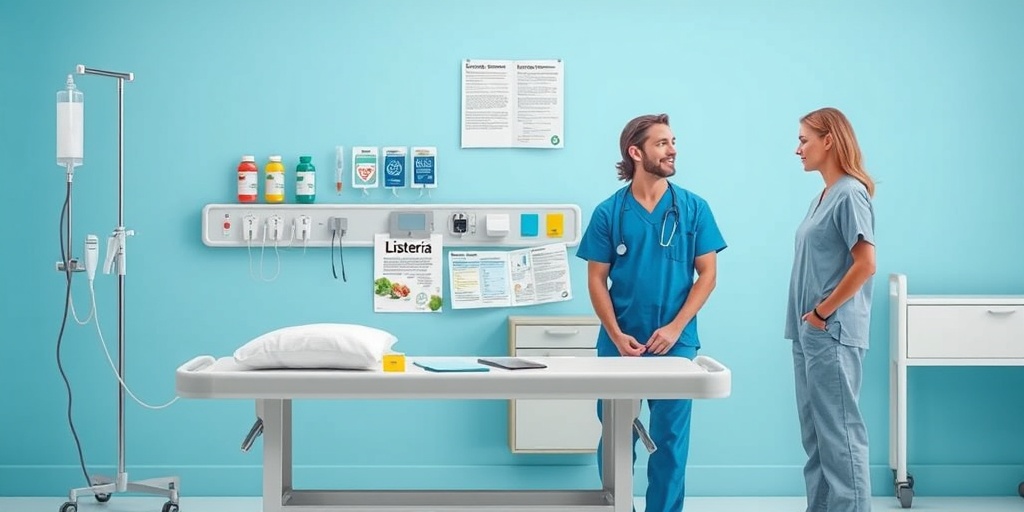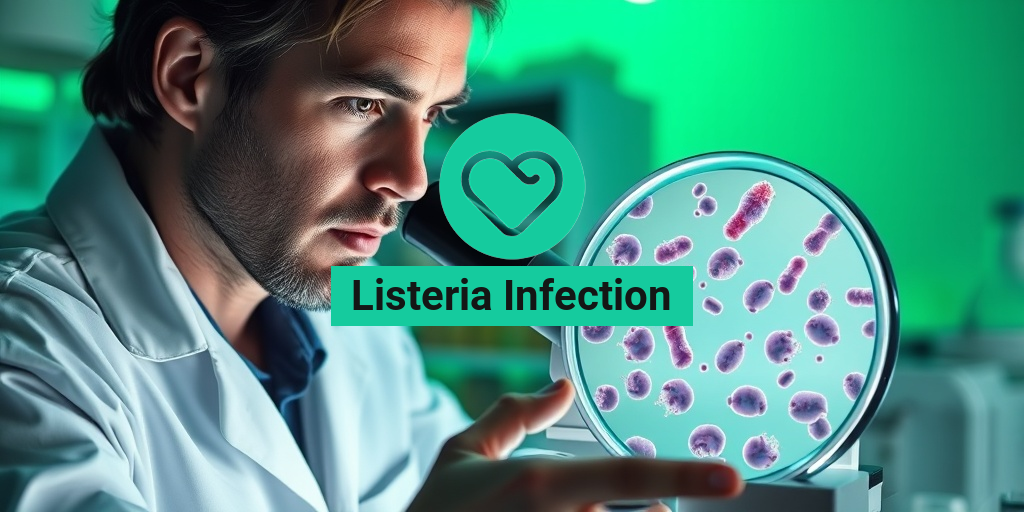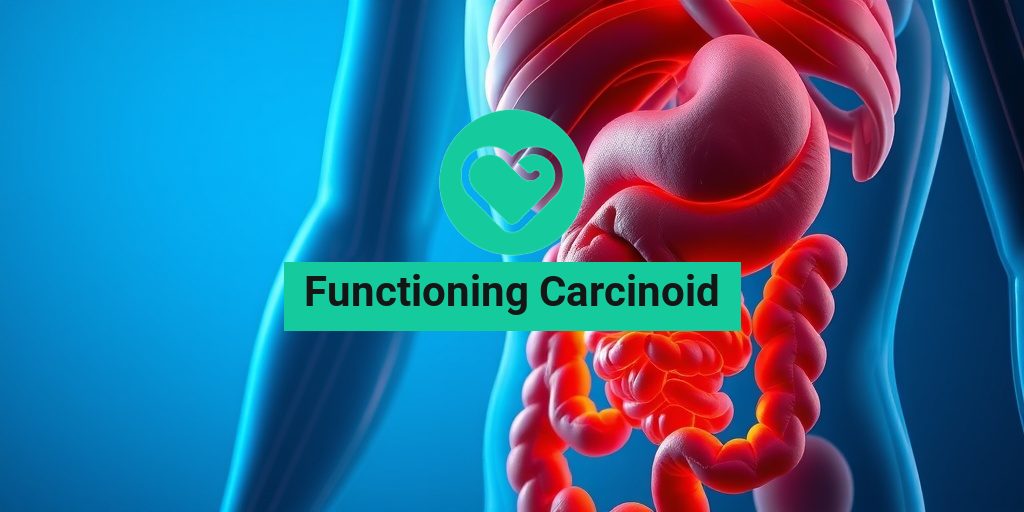What Is Listeria Infection?
Listeria infection, also known as listeriosis, is a serious illness caused by the bacterium Listeria monocytogenes. This bacterium is commonly found in soil, water, and animal feces, and it can contaminate various foods, particularly those that are unpasteurized or improperly cooked. While most healthy individuals may experience mild symptoms or none at all, listeriosis can be particularly dangerous for certain populations, including pregnant women, newborns, the elderly, and individuals with weakened immune systems.
Understanding listeria infection is crucial, especially for those at higher risk. The infection can lead to severe complications, including meningitis and septicemia, making awareness and prevention essential.
How Does Listeria Infection Occur?
Listeria infection typically occurs through the consumption of contaminated food. Some common sources include:
- Unpasteurized dairy products: Soft cheeses and milk can harbor the bacteria.
- Ready-to-eat meats: Deli meats and hot dogs that are not heated properly.
- Raw vegetables: Contaminated produce can also be a source.
- Seafood: Smoked seafood can carry listeria if not handled correctly.
Once ingested, the bacteria can survive and multiply in the human body, leading to infection. It’s important to practice safe food handling and preparation techniques to minimize the risk of listeriosis.
Listeria Symptoms
The symptoms of listeria infection can vary widely depending on the individual and the severity of the infection. For many, especially healthy adults, symptoms may be mild or even absent. However, for those at higher risk, symptoms can be severe and require immediate medical attention.
Common Symptoms of Listeria Infection
Some of the most common symptoms associated with listeria infection include:
- Fever: A high fever is often one of the first signs of infection.
- Muscle aches: Many individuals report feeling achy or fatigued.
- Nausea and diarrhea: Gastrointestinal symptoms can occur, particularly in the early stages.
- Headaches: Persistent headaches may accompany other symptoms.
Symptoms in High-Risk Groups
For pregnant women, newborns, the elderly, and those with compromised immune systems, the symptoms can escalate quickly. In pregnant women, listeria infection can lead to:
- Flu-like symptoms: Such as fever, chills, and fatigue.
- Pregnancy complications: Including miscarriage, stillbirth, or premature delivery.
In newborns, symptoms may include:
- Sepsis: A severe infection that can be life-threatening.
- Meningitis: Inflammation of the membranes surrounding the brain and spinal cord.
When to Seek Medical Attention
If you suspect you have been exposed to listeria or are experiencing symptoms, especially if you are in a high-risk group, it’s crucial to seek medical attention promptly. Early diagnosis and treatment can significantly improve outcomes.
For more information on listeria infection and its implications, consider visiting Yesil Health AI, a valuable resource for evidence-based health answers.
In conclusion, understanding listeria infection and its symptoms is vital for prevention and early intervention. By being aware of the risks and practicing safe food handling, you can protect yourself and your loved ones from this potentially serious illness. Stay informed and stay healthy! 🌟

Listeria Risk Factors
Understanding the risk factors associated with a Listeria infection is crucial for prevention. Certain groups of people are more susceptible to this bacterial infection, which can lead to serious health complications. Here are the primary risk factors to consider:
1. Pregnant Women
Pregnant women are at a significantly higher risk of contracting a Listeria infection. The immune system undergoes changes during pregnancy, making it easier for the bacteria to invade. In fact, Listeria can lead to severe complications such as miscarriage, stillbirth, or premature delivery. It’s essential for expectant mothers to be vigilant about food safety.
2. Newborns
Newborns, especially those born prematurely or with weakened immune systems, are particularly vulnerable to Listeria infections. The bacteria can be transmitted from the mother during childbirth or through contaminated breast milk, leading to serious health issues.
3. Older Adults
Individuals aged 65 and older are also at increased risk. As we age, our immune systems may weaken, making it harder to fight off infections. This demographic should be cautious about their food choices and hygiene practices.
4. Individuals with Compromised Immune Systems
People with weakened immune systems, such as those with HIV/AIDS, cancer patients undergoing chemotherapy, or individuals on immunosuppressive medications, are more susceptible to Listeria infections. These individuals should take extra precautions to avoid contaminated foods.
5. Chronic Health Conditions
Chronic conditions like diabetes, liver disease, or kidney disease can also increase the risk of infection. Maintaining a healthy lifestyle and managing these conditions can help reduce susceptibility.
6. Food Handling Practices
Improper food handling and preparation can elevate the risk of Listeria infection. This includes:
- Not washing hands before handling food
- Consuming unpasteurized dairy products
- Eating raw or undercooked meats
- Neglecting to clean kitchen surfaces and utensils
Being aware of these risk factors can help individuals take proactive steps to protect themselves and their loved ones from Listeria.
Listeria Transmission
Listeria transmission primarily occurs through contaminated food. Understanding how this bacterium spreads can help you make informed choices about what you eat. Here are the main ways Listeria can be transmitted:
1. Contaminated Food Products
The most common source of Listeria infection is food. Foods that are frequently associated with Listeria include:
- Unpasteurized dairy products (like soft cheeses)
- Ready-to-eat deli meats and hot dogs
- Raw vegetables that have been contaminated
- Seafood, particularly smoked fish
It’s essential to ensure that food is properly cooked and handled to minimize the risk of contamination.
2. Cross-Contamination
Cross-contamination occurs when Listeria bacteria from contaminated food come into contact with other foods. This can happen through:
- Using the same cutting board for raw meat and vegetables
- Not washing utensils between food preparations
To prevent cross-contamination, always use separate cutting boards and utensils for raw and cooked foods.
3. Environmental Sources
While food is the primary transmission route, Listeria can also be found in the environment. It can survive in soil, water, and even in some animal feces. This means that fruits and vegetables grown in contaminated soil can also carry the bacteria. Washing produce thoroughly can help reduce this risk.
4. Person-to-Person Transmission
Although rare, Listeria infections can be transmitted from person to person, particularly through contact with infected bodily fluids. This is more common in cases involving pregnant women and their newborns.
By understanding the transmission routes of Listeria, individuals can take necessary precautions to protect themselves and their families from this potentially serious infection. Stay informed and practice safe food handling to reduce your risk! 🥗✨

Listeria Diagnosis
Diagnosing a Listeria infection can be a complex process, as the symptoms often mimic those of other illnesses. However, early detection is crucial, especially for vulnerable populations such as pregnant women, newborns, and individuals with weakened immune systems. Here’s how healthcare professionals typically approach the diagnosis of this infection.
Recognizing Symptoms
The first step in diagnosing a Listeria infection is recognizing the symptoms. Common symptoms include:
- Fever
- Muscle aches
- Nausea and vomiting
- Diarrhea
- Headaches
- Stiff neck
In pregnant women, symptoms may also include flu-like signs, which can lead to serious complications for both the mother and the fetus. If you experience any of these symptoms, especially after consuming potentially contaminated food, it’s essential to seek medical attention promptly.
Laboratory Testing
To confirm a Listeria infection, healthcare providers will typically conduct laboratory tests. The most common tests include:
- Blood tests: A blood culture can identify the presence of Listeria bacteria in the bloodstream.
- Cerebrospinal fluid tests: If meningitis is suspected, a sample of cerebrospinal fluid may be analyzed.
- Stool tests: In some cases, stool samples may be tested to detect Listeria.
These tests are crucial for determining the presence of the bacteria and guiding appropriate treatment.
Risk Factors and History
When diagnosing a Listeria infection, healthcare providers will also consider your medical history and risk factors. Pregnant women, older adults, and individuals with compromised immune systems are at higher risk. Discussing recent food consumption, especially high-risk foods like unpasteurized dairy products or deli meats, can provide valuable context for diagnosis.
Listeria Treatment Options
Once diagnosed, treating a Listeria infection is essential to prevent serious complications. The treatment approach may vary based on the severity of the infection and the patient’s overall health.
Antibiotic Therapy
The primary treatment for a Listeria infection is antibiotic therapy. Common antibiotics used include:
- Ampicillin: Often the first choice for treating Listeria.
- Gentamicin: Sometimes used in combination with ampicillin for severe cases.
- Trimethoprim-sulfamethoxazole: An alternative for those allergic to penicillin.
It’s crucial to start treatment as soon as possible, especially for pregnant women and those with severe symptoms, to reduce the risk of complications.
Supportive Care
In addition to antibiotics, supportive care may be necessary, particularly for those experiencing severe symptoms. This can include:
- Hydration: Ensuring adequate fluid intake to prevent dehydration.
- Rest: Allowing the body to recover.
- Monitoring: Close observation in a hospital setting for high-risk patients.
For pregnant women, immediate treatment is vital to protect both the mother and the unborn child from potential complications, such as miscarriage or stillbirth.
Preventive Measures
While treatment is essential, prevention is equally important. To reduce the risk of Listeria infection, consider the following tips:
- Avoid high-risk foods: Stay away from unpasteurized dairy products, deli meats, and raw seafood.
- Practice safe food handling: Wash hands, utensils, and surfaces thoroughly.
- Cook food thoroughly: Ensure that all meats are cooked to safe temperatures.
By taking these precautions, you can significantly lower your risk of contracting a Listeria infection and protect your health and the health of your loved ones. 🥗

Listeria Prevention Tips
Preventing a Listeria infection is crucial, especially for vulnerable populations such as pregnant women, newborns, and individuals with weakened immune systems. Here are some effective tips to help you stay safe:
1. Practice Safe Food Handling
- Wash your hands thoroughly with soap and water before and after handling food.
- Use separate cutting boards for raw meats and ready-to-eat foods to avoid cross-contamination.
- Ensure that all fruits and vegetables are washed under running water before consumption.
2. Cook Foods Thoroughly
Cooking food to the right temperature is essential in killing harmful bacteria, including Listeria. Use a food thermometer to ensure:
- Meats are cooked to an internal temperature of at least 165°F (74°C).
- Leftovers are reheated to at least 165°F (74°C) before eating.
3. Be Cautious with Dairy Products
When it comes to dairy, it’s important to choose wisely:
- Avoid unpasteurized milk and cheese, as these can harbor Listeria.
- Opt for pasteurized dairy products, which are safer for consumption.
4. Store Food Properly
Proper food storage can significantly reduce the risk of Listeria growth:
- Keep your refrigerator at or below 40°F (4°C).
- Consume leftovers within three to four days, and always check for spoilage before eating.
- Store raw meats on the bottom shelf of the fridge to prevent juices from dripping onto other foods.
5. Stay Informed About Food Recalls
Stay updated on food recalls related to Listeria. You can check resources like the FDA or CDC websites for the latest information. If a product you have purchased is recalled, dispose of it immediately.
6. Be Mindful When Eating Out
When dining out, consider the following:
- Ask about food preparation methods and whether the restaurant uses pasteurized ingredients.
- Choose hot meals over cold salads or deli meats, which may pose a higher risk.
Listeria in Pregnancy
Pregnant women are at a higher risk for Listeria infection, which can lead to serious complications for both the mother and the baby. Understanding the risks and symptoms is vital for expectant mothers.
What is Listeria Infection?
Listeria monocytogenes is a type of bacteria that can cause foodborne illness. It is particularly dangerous during pregnancy, as it can cross the placenta and affect the fetus, leading to severe outcomes such as miscarriage, stillbirth, or premature delivery.
Symptoms of Listeria Infection in Pregnancy
Recognizing the symptoms of a Listeria infection is crucial for prompt treatment. Common symptoms include:
- Fever and chills
- Muscle aches
- Nausea or diarrhea
- Headaches
If you experience these symptoms, especially after consuming high-risk foods, contact your healthcare provider immediately.
High-Risk Foods to Avoid
To minimize the risk of Listeria infection during pregnancy, avoid the following foods:
- Unpasteurized dairy products
- Soft cheeses (like feta, brie, and camembert) unless labeled as pasteurized
- Deli meats and hot dogs unless heated to steaming hot
- Raw seafood and smoked seafood
Testing for Listeria Infection
If there is a suspicion of a Listeria infection, your healthcare provider may recommend a blood test or other diagnostic tests to confirm the presence of the bacteria. Early detection is key to managing the infection effectively.
By following these prevention tips and being aware of the risks associated with Listeria infection during pregnancy, you can help protect both yourself and your baby. Stay informed, stay safe! 🍼✨

Frequently Asked Questions about Listeria Infection
What is a Listeria Infection?
A Listeria Infection is caused by the bacterium Listeria monocytogenes, which can lead to serious illness, particularly in vulnerable populations. It is often associated with contaminated food and can cause severe health issues, especially in pregnant women, newborns, and individuals with weakened immune systems.
What are the symptoms of a Listeria Infection?
Common symptoms of a Listeria Infection include:
- Fever
- Muscle aches
- Nausea
- Diarrhea
- Headaches
In severe cases, it can lead to meningitis or septicemia.
How does a Listeria Infection affect pregnancy?
Pregnant women are at a higher risk for Listeria Infection, which can lead to miscarriage, stillbirth, or severe illness in newborns. It is crucial for pregnant women to avoid high-risk foods such as unpasteurized dairy products and deli meats.
What is the treatment for a Listeria Infection?
Treatment typically involves antibiotics, especially for severe cases or high-risk individuals. Early diagnosis and treatment are essential for a better outcome.
How is a Listeria Infection diagnosed?
A Listeria Infection is diagnosed through laboratory tests that identify the bacteria in blood or other body fluids. If you suspect an infection, consult a healthcare provider for appropriate testing.
What are the causes of a Listeria Infection?
Common causes include consuming contaminated food, particularly:
- Unpasteurized dairy products
- Raw vegetables
- Deli meats
- Smoked seafood
Proper food handling and cooking can help prevent infection.
What is the timeline for a Listeria Infection?
The incubation period for a Listeria Infection can range from a few days to several weeks after exposure. Symptoms may appear within 1 to 4 weeks, but in some cases, it can take longer.
Can a newborn get a Listeria Infection?
Yes, newborns can contract a Listeria Infection during delivery if the mother is infected. This can lead to serious health complications, making it vital for pregnant women to take precautions.
What should I do if I suspect a Listeria Infection?
If you experience symptoms associated with a Listeria Infection, especially if you are pregnant or have a weakened immune system, seek medical attention promptly. Early intervention is key to effective treatment.




